#based on Death and Life by Klimt
Explore tagged Tumblr posts
Text
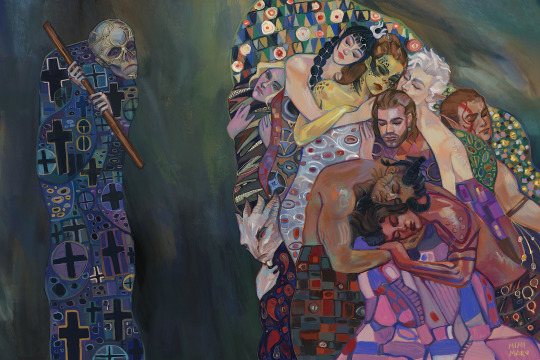
I Want To Live (Life and Death)
17K notes
·
View notes
Text

they come together with a kiss
meronia event prompt(s): hair | reunion

#death note#meronia#mello#near#meroniaevent#YIPPEE!!!!!#MERONIA EVENT IS STARTING!!!!!!!!!#the pose is based on klimt’s kiss btw i was in a mood for klimt when i drew this#i have like 2 other pieces finished for meronia event and i will try my hardest to finish more but y’all i am dying from school + life rn#nevertheless i will persist !!
119 notes
·
View notes
Text

You will never be part of this world, Lonely God
Based on Gustav Klimt's painting "Death and Life"

230 notes
·
View notes
Text

Based on Klimts Life and Death painting ✨
#artists on tumblr#art#anime art#artist#fanart#anime#anime aesthetic#digital artist#anime fanart#arcane#arcane fanart#isha arcane#jinx arcane#arcane jayce#jayvik#ekko arcane#gustav klimt
375 notes
·
View notes
Text
Rewind the Tape —Episode 1
Art of the episode
During our rewatch, we took note of the art shown and mentioned in the pilot, and we wanted to share. Did we miss any? Do you have any thoughts about how these references could be interpreted? How do you think Armand and Louis go about picking the art for their penthouse in Dubai?

The Fall of the Rebel Angels
Peter Bruegel the Elder, 1562
This painting is featured in the Interview with the Vampire book, and it was important enough to be included in the draft pilot script!

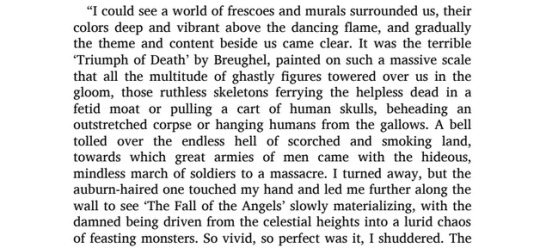
Bruegel the Elder was among the most significant Dutch and Flemish Renaissance artists. He was a painter and print-maker, known for his landscapes and peasant scenes.

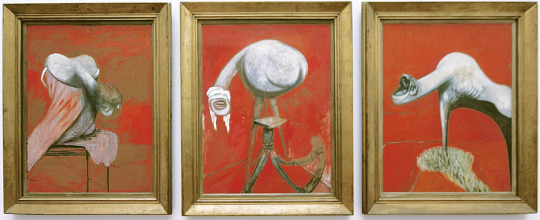
Three Studies for Figures at the Base of a Crucifixion
Francis Bacon, 1944
Bacon was an Irish figurative painter, known for his raw, unsettling imagery and a number of triptychs and diptychs among his work. At a time when being gay was a criminal offense, Bacon was open about his sexuality, and was cast out by his family at 16 for this reason. He destroyed many of his early works, but about 590 still survive. The Tate, where these paintings are displayed, says this about the work: "Francis Bacon titled this work after the figures often featured in Christian paintings witnessing the death of Jesus. But he said the creatures represented the avenging Furies from Greek mythology. The Furies punish those who go against the natural order. In Aeschylus’s tragedy The Eumenides, for example, they pursue a man who has murdered his mother. Bacon first exhibited this painting in April 1945, towards the end of the Second World War. For some, it reflects the horror of the war and the Holocaust in a world lacking guiding principles."

On the Hunt or Captain Percy Williams On A Favorite Irish Hunter and Calling the Hounds Out of Cover
Samuel Sidney, 1881 [Identified by @vfevermillion.] and Heywood Hardy, 1906 [Identified by @destinationdartboard.]
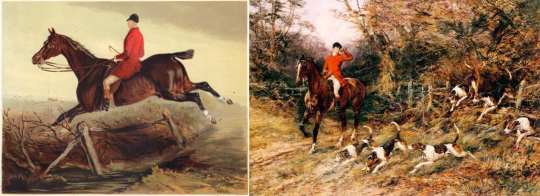
Sidney was an English writer, and his prints usually accompanied his publications about hunting, agriculture, and about settling Australia during the colonial period. Hardy, also British, was a painter, in particular an animal painter. There's also a taxidermy deer, ram, and piebald deer on the wall.
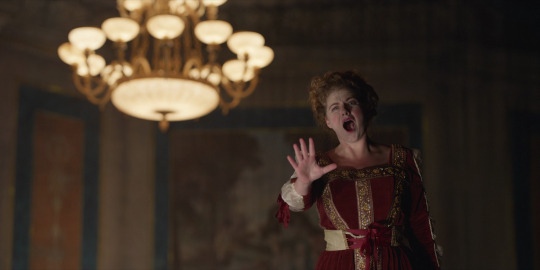
Iolanta
Pyotr Tchaikovsky, 1892
The opera Louis and Lestat go to was composed by Tchaikovsky, another gay artist. The play tells a story "in which love prevails, light shines for all, lies are no longer necessary and no one must fear punishment," as put by Susanne Stähr for the Berliner Philharmoniker.

Strawberries and Cream
Raphaelle Peale, 1816 [Identified by @diasdelfuego.]
Peale is considered to have been the first professional American painter of still-life.

Outfits inspired by J.C. Leyendecker
Leyendecker was one of the most prominent and commercially successful freelance artists in the U.S. He studied in France, and was a pioneer of the Art Deco illustration. Leyendecker's model, Charles Beach, was also his lover of five decades. You can read costume designer Carol Cutshall's thoughts on these outfits on her Instagram.

The Artist's Sister, Melanie
Egon Schiele, 1908 [Identified by @dwreader.]
Schiele was an Austrian expressionist painter and protege of Gustav Klimt. Many of his portraits (self portraits and of others) were described as grotesque and disturbing.
A Stag at Sharkey's
George Wesley Bellows, 1909 [Identified by @vfevermillion.]
Bellows was an American realist painter, known for his bold depictions of urban life in New York City.

Mildred-O Hat
Robert Henri, undated (likely 1890s) [Identified by @nicodelenfent, here.]
Henri was an American painter who studied in Paris, where he learned from the Impressionists and determined to lead an even more dramatic revolt against American academic art.
Starry night
Edvard Munch, 1893 [Identified by @vfevermillion.]
Munch was a Norwegian painter, one of the best known figures of late 19th-century Symbolism and a great influence in German Expressionism in the early 20th century. His work dealt with psychological themes, and he personally struggled with mental illness.
If you spot or put a name to any other references, let us know if you'd like us to add them with credit to the post!
Starting tonight, we will be rewatching and discussing Episode 2, ...After the Phantoms of Your Former Self. We hope to see you there!
And, if you're just getting caught up, learn all about our group rewatch here ►
#louis de pointe du lac#daniel molloy#lestat de lioncourt#vampterview#interview with the vampire#iwtv#amc interview with the vampire#interview with the vampire amc#amc iwtv#iwtv amc#IWTVfanevents#rewind the tape#in throes of increasing wonder#analysis and meta#art of the episode
95 notes
·
View notes
Text
Thanks for the support!
first of all don't worry,I am reading your comments and I understand, I also wsnted to tear off my skin while drawing, the feeling is mutual I feel you
The Sandman Spoilers below!
Ohhh boy, I'm a fan of representing artistic pieces, it's been a while since I saw several of Klimt's works and this painting on which I based it left me thinking and I said "hey I like the concept" this also crossed that I finally have a physical copy of The Kindly Ones and oof what a combination!
The three ages of women represent the cycle of life
While the two women with more vibrant colors represent a younger stage, the woman with more opaque contrast represents decadence.
I like the fact that the little girl with the young woman represents both youth and childhood and also motherhood.
In my first drawing I wanted to represent the same thing! I always think in that comment that Daniel!Dream's appearance is actually what any young Dream would have, so easy symbolizes both a very young dream and the fatherhood of Morpheus (which greatly influences the development of its history and is a very important element...) the flowers on the head that symbolize bloom in the original work, and of course I would use poppies...
By the way, I wanted to maintain the influence of the original background of the work in the first image to provide contrast.
Now with the second image, it is very easy to say that I wanted to rip my heart out, every time I see those panels of Morpheus waiting for Death in the rain I want to scream, of course the storm in his worst moments...in the original work the woman looks decayed by time and isn't Morpheus?
Ok.ok.ok I understand.
I don't know if this is so much a comment or an explanation lol 😭 more like me rambling about what I was thinking while I was drawing, maybe someone will be interested to know.
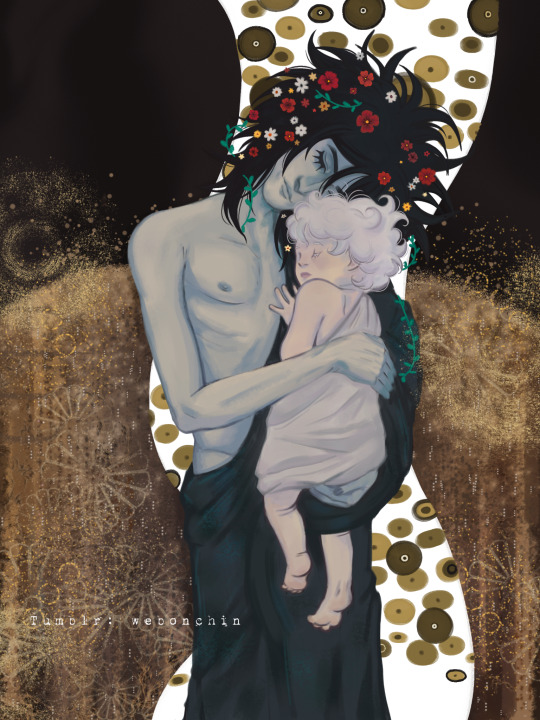
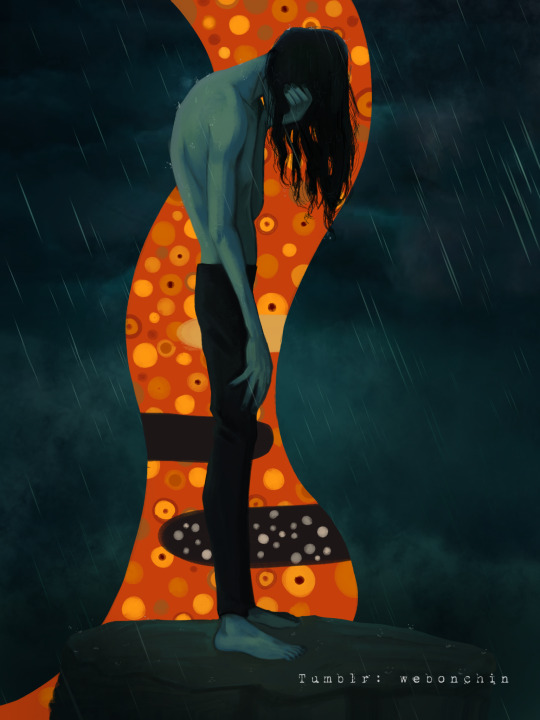
The Three Ages of a Dream
Based on the painting "The Three Ages of Woman" by Gustav Klimt
757 notes
·
View notes
Text

Gustav Klimt loved to include symbolism in his paintings, such as in this one, “life and death”. The subject matter of this painting is the grim reaper and figures of people tied together. It can be considered a representational artwork as we recognise figures of people and the subject matter. Klimt painted this artwork during his “golden period” ; this painting makes part of his famous art nouveau and modern artworks. He emphasizes the people by using soft and warm tones which contrast with the cold and dark tones of the background and of the grim reapers' clothes. By this contrast of tones he makes the emphasis on the vitality of life. As the subject matter is painted using patterns, the negative space that surrounds it helps to not overload the artwork with detail and bring attention to the figures. The painting consists mostly of curved and flowy lines, making the painting soft and pleasant to look at. The proportions of people are not accurate - an eye-catching stylised distortion proper to the art moderne style.
This image, as its title suggests, is a metaphor for life and death. I find that mortality is the main sign that Klimt wanted to communicate, using the signs of death and life. In this painting he represented the grim reaper as a signifier of death, and all the intertwined people - let's call them the Life group - as the signifier of life. The grim reaper is a well known symbol that artists have used since ancient times to represent death. The grim reaper looks at the Life Group and smirks, knowing well that they all will join him someday. Klimt here wanted to pass the message that life and death are interconnected and cannot exist apart from one another, and death is the logical end to everything, but also the beginning of everything new. Breaking the traditions, Klimt represented death before life, and the painting's name ”death and life” puts death in the first place; Klimt wanted to show that death is not only the end but the beginning as well. This painting touches on Memento Mori- “remember that you will die”. Klimt also included symbolism in the patterns, such as the crosses on the grim reaper's clothes which represent the cemetery, and the green pattern behind the Life Group which represent fauna. The artwork is subjective and based solely on the artist's perspective. He plays with emotions that he represents on faces ,makes interesting use of colors and patterns to bring the viewer's attention where he wants it to be; he also uses symbolism to convey the meaning of the painting.
In my opinion this painting translates its message effectively. I personally see it as an irony about life; even the most beautiful living is always meant to die. Like flowers, those people, full of life, will eventually fade and the grim reaper - who stands and waits for the moment to come - will take possession over them. When I look at klimt’s artwork I feel amazed by the beauty of his interpretation and melancholic at the same time. Once again, “memento mori”- mortality is the main symbol here. The elements of art and principles of design that the artist employed translate well his message.
Image source:
Klimt, Gustav. “Death and Life”. Wikipedia, July 15, 2023.
https://en.wikipedia.org/wiki/Death_and_Life. Accessed 2
november 2023.
0 notes
Text
I don’t know why but I have spent way too much time developing a headcanon about how just about everyone behaves when either they are ill/injured or you/other characters are ill/injured. Will this lead to me actually writing a fic? (the odds aren’t great given how long it’s been since I’ve even written anything with my own characters let alone trying to stay true to the sketch of someone else’s) Who knows, but I guess this is the closest I’ve come to writing anything at all in far too long.
Sholmes:
*I think we can all agree that Sholmes is the absolute worst when he’s sick.
*He’s totally the type who being the slightest bit ill turns into a complete dramatic bitch and hams up the tiniest of colds like he’s about to die from the consumption. He lightly groans as though the effort of extending his arm fully to take a Kleenex out of the box himself is too much. Like my old rat D’onofrio his breathing is fine if he has no idea you are home, but the second he notes your presence every breath is a wheezy death rattle until you come and worry and fuss over him until his attention meter is full up.
*But also as soon as there’s something he actually wants to do he’s magically cured and runs off without even putting on a coat.
*In a modern AU he for some reason spends a lot of time on WebMD either convincing you that his allergy-related headache is a rare usually fatal disease. Or that you probably have a rare malady that is exacerbated by eating pheasant he should probably go ahead and eat your pheasant because he’s only thinking of your health.
* When you are sick it is unpredictable at best, but it depends on how sick you actually are. There will probably be a variety of dubious cures and tinctures which you should probably ignore unless Iris made them.
*He has literally tied Kazuma to a bed (this will make more sense shortly).
*He will also somehow claim to find Ryunosuke’s take all the meds at once approach reasonable.
Kazuma:
*Asogi is also a terrible patient who will drive you to want to drink, but in the opposite fashion to Sholmes.
*He’s the ‘it’s only a flesh wound’ type who will thoroughly ignore any and all evidence of illness or injury claiming he is perfectly fine and hale until he is half dead with it and passes out
*Even after he regains consciousness will continue to argue that he will be in tomorrow he only needs to run it under a cold tap.
*You will have to tie him to a bed to get him to take doctor’s orders, and then he will be sullen about it.
*Once you get him into a room and confiscate clothes he could go outside in where he is sulking he will change tactics and he will order you around a lot trying to make you angry enough to throw your hands up and let him take care of himself, except with Ryunosuke who he knows this won’t work on so he just tries to wheedle him into bringing his clothes back and makes double entendres and suggestive comments about being tied to the bed.
*When it is you who is sick he will become the overbearing one and you won’t be sure whether that is because he worries about you or because it’s revenge for when he was sick.
Ryunosuke:
*Ryunosuke is challenging when he’s ill because he will acknowledge the illness and neither exaggerate or ignore it, but he is too concerned about whether it inconveniences everyone else for him to be ill, so he will try to downplay or hide the fact he’s as sick as he is.
*He’ll try to get well as quick as possible hence doing dumb stuff like taking all the meds at once.
*He can be reasoned with, like you could convince him to go home and take a day off, or that if he shows up sick he’ll get you all sick, but he’ll try to work from home or come back before he’s 100% or he’ll also try to prevent anyone from helping him because he feels like he’s causing extra work or that he might get someone sick.
*Can also be intimidated into being a good patient with the threat of a Susato Takedown or Barok just glaring at him until he caves.
*When you are sick he worries over you and runs around trying to make everything easy for you. Sholmes will take advantage of that to the max, so he must be sent elsewhere to avoid that.
*Once threatened to tie Kazuma to the bed so he would follow doctor’s orders. Once he realized how suggestive that sounded and got flustered he gave up on that plan (even though everyone agreed it was actually the only plan that was likely to be successful.) Now they rib him about it every time either he or Asogi get ill.
Susato:
*Susato is level-headed and actually a fairly good patient to no one’s surprise, provided she is the only one who is ill.
*She will also be worried about being an inconvenience, but has the sense to do what’s needed to get better and then tries to make it up to everyone after even though no one thinks that’s necessary
*She won’t let anyone help her though unless she really needs it. As she doesn’t want them to get sick or to fuss.
*If others are sick she will tend to put them all before her even if she’s sicker, and gets stubborn about this. This has led to at least one occasion of Sholmes dropping the theatrics and Kazuma acting like a model patient at the same time.
* When you’re sick she is no nonsense and actually helpful. She spends a lot of time shooting down Sholmes’ webMD self diagnoses, and makes Ryunosuke give her his prescriptions so she can administer the dosage because she doesn’t have time to drag him to the hospital. She has also had to threaten the Susato takedown on Kazuma more than once if he doesn’t go see the doctor today.
Gina:
*Gina is in the Kazuma mold of patient, except when you finally force her to act like she is as sick as she is, she turns into Sholmes.
*When you are ill she is aggressive about you taking care of yourself and worries, she has a lot of past trauma with people dying from her time trying to take care of her orphan army in the rookeries.
*Is not above threats, guilt-trips, and shooting you with a smoke grenade full of vitamin c or eucalyptus vap-o-rub mist.
*has pickpocketed Ryunosuke’s prescription to give to Susato more than once to avoid him taking them all at once.
Iris-
*When ill Iris is a lot more like Susato, but she totally tries to invent her own tea-based cures, and she will also downplay or hide that she’s sick because she doesn’t want anyone to worry about her, but doesn’t go overboard with it the way Ryunosuke does.
*She is pretty much immune to Sholmes’ theatrics at this point, but sometimes will make up new imaginary web md illnesses that he might have to amuse herself.
*She will mother you with tea-based or soup-based cures which you will be safe consuming and will make you feel better emotionally if not physically, but often physically as well.
*Has also modified one of her smoke grenade guns to fire eucalytpus vap-o-rub mists, and also so they can knock Kazuma or Gina out safely and temporarily so they can be made to convalesce when they are being extra stubborn.
Barok-
* somehow Barok is the best patient of all of them. It’s probably the only time that he is truly polite and courteous with no sarcastic requests for forgiving discourtesies.
*This comes from some combination of Klimt telling him as a boy about a noble’s responsibility to the people of his estate (and his actually taking this concept to heart unlike a lot of nobles) and the sheer number of times he has had to rely on doctor’s, nurses, and staff due to the numerous attempts on his life over the years.
*He will downplay the seriousness of an injury especially out of habit and so as not to worry those who he cares about (though he finds it shocking always that anyone cares about him) but he will always get it seen to and respect orders provided they come from a professional and there are reasons given.
*He will insist that his staff gets things if he needs them and not you, but this is because he wants the staff to feel comfortable and he pays them extra compensation for it. Were he contagious he would not allow them but would pay their wages for them to be away from his home. (This is a big secret and his staff is very loyal to him even without this money. It’s just like the chalices and vintages all the theatrics of it is to fund these families of artisans. Charity without charity.)
*When you are sick, except maybe Sholmes who he just can’t even, he is kind and no nonsense. He thinks you should come to stay in his guest room and been seen by his doctor, that way you’ll get the best care and recover quicker. He’ll have his staff take care of you (but also report back to him if you aren’t being cooperative. He will tell you to think nothing of it, you’re friends and he’s rich and has no family left (except Iris and she doesn’t even live with him) so what else would he do with it, besides it provides wages.
*He is not above intimidating Ryunosuke (sometimes also Gina ) into convalescing as they should.
*This doesn’t work with Kazuma who he had also considered tying to the bed, but instead decided to let him have it his way and then when he got bad enough and passed out took him to the estate anyway and made sure the doctors told him exactly how much longer he had to convalesce than he would have if he’d listened to Barok in the first place.
*He brings this up every single time so they can just skip to the part where Kazuma sulks and is a grouchy patient.
*Is the only person that doesn’t join in with the group pastime of ribbing Ryunosuke about threatening to tie Kazuma to the bed To make him follow doctor’s orders.
#dgs#dgs spoilers#I mean not really spoilers unless you are like how would they have talked#ryunosuke naruhodo#kazuma asougi#susato mikotoba#iris wilson#gina lestrade#herlock sholmes#barok van zieks#random headcanon#stronghart would only let himself be sick for 26 minutes
33 notes
·
View notes
Text
thegeekyartist said: Klimt paintings I feel make for interesting narratives, Death and Life is one of my faves to look at. Also have you ever looked at the work of Artemisia Gentileschi? She was an incredible baroque painter at a time when women weren't often given those opportunities to study art. A lot of her work is based on actual stories, but the emotion is just beyond good. Her version of Judith Beheading Holofernes is so much more visceral than some others.
---------------
Thank you for the recs!! I looked at Death and Life and it is gorgeous but also... literally the exact same thing I wrote about last time lmaooo. (There was no way to know, I just think the odds of this happening twice in a row are very funny.) And I am familiar with Gentileschi’s work! I like it a lot! I’m a little hesitant to do this exercise with a painting that’s already attached to a story (kind of seems to undermine the purpose), but if you know of one you really like that isn’t a depiction of an extant story, I’m more than receptive!
#replies#writing liveblogging#recs for entire artists are helpful but specific paintings is more helpful#bc then I can't look through like a dozen paintings to choose one I like best#I like the challenge of 'you must make THIS work'#but that's just me
3 notes
·
View notes
Text
Art History Reader: Gestalt Theory
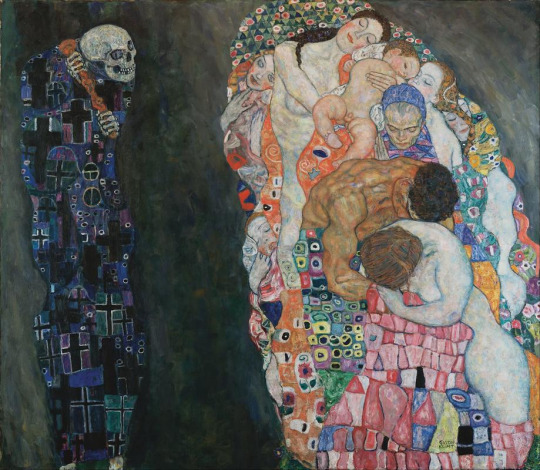
Gustav Klimt, Death and Life, 1908, Leopold Museum.
In any fictional crime show, the detective walks into a scene full of chaos. Instead of being overwhelmed, the detective investigates and catches specific small details to discover what occurred. Generally speaking, they are creating order and organization out of specific elements amongst the disordered scene using Gestalt principles, just like artists and designers do. The Gestalt is based in the mind rather than simply what is physically in front of us. Art viewers and critics are just detectives for works of art, which can sometimes be more absurd (or even derivative) than a crime scene.
The Germans have long influenced the way we view art. From dark Gothic architecture and reproduction using the printing press, to the functionality of the Bauhaus and concrete designs of Brutalism, German art reigns. The modern discipline of art history and theory is built on the thoughts of German philosophers and theorists, like Johann Joachim Winckelmann’s development of aesthetics and Heinrich Wölfflin’s understanding of formal analysis. Gestalt theory similarly originated in Germany. Within art theory, the practice that explains how we think about art and its functions, the psychology of the Gestalt helps us understand how our brain interprets art.
Focusing primarily on composition, the term gestalt is a German word meaning “unified whole.” In the 1920s, while Sigmund Freud was psychoanalyzing our deep desires, German psychologists Max Wetheimer, Kurt Koffka, and Wolfegang Kohler were developing Gestalt psychology. The group wanted to better understand how our brain interprets the visual chaos of our world. The principles they developed explained how we visualize specific elements of our world, and how our minds find order and organization. This is a step further than the elements or principles of art and design. Design industries have long used these rules to create unique and creative designs. These usually are seen as a whole, an intriguing eye-catching logo, while the visual detective will see the references to the concept, product, or use. Below are examples of the Gestalt principles in use. Put on your art detective hat, and see if you can spot the Gestalt principles used.
Closure:
With closure, our minds like to see complete lines, shapes, and forms in front of us. When an artist uses gaps in their lines, whether intentional, due to a stiff paint brush, or unintentional, with a pen that runs out of ink, our mind closes those gaps to read the shape as a complete object. This can often be seen with the use of contrast; the use of a dark shape against a light shape can create an implied line or shape that we see as whole. In Mary Cassatt’s The Coiffure, the edges of the woman’s dress are not drawn in harsh outline, but the contrast of the background against the white fabric creates closure. Jean Metzinger’s La Danse, Bacchante uses a pixelated approach to the figure; each square is a specific hue having space between each. However, when viewed from a distance, the line and form of the figure are closed.
The Coiffure by Mary Cassatt
La danse, Bacchante by Jean Metzinger
Common Region:
Our brain also likes to group specific elements together to relate them within a closed area. This occurs within shape and color most often; elements within a specific colored background will be seen as being related. In Frederic Remington’s The Mier Expedition: The Drawing of the Black Bean, we see common regions being used in the narrative based on the placement of people within the composition as well as the colors of their clothing. We will visually group together those on the right with the lighter colored clothing as one group and those on the left with the tan clothing as a separate group. Within landscapes, Marsden Hartley uses common ground in The Summer Camp, Blue Mountain. This style is beginning to veer into abstraction and stippling. As the dark, cool colors of the mountain group the individual strokes together in the background, the green and red paint strokes are separated and grouped together in the foreground.
The Mier Expedition: The Drawing of the Black Bean by Frederic Remington
The Summer Camp, Blue Mountain by Marsden Hartley
Figure/Ground:
The use of the figure/ground theory is one of the most ubiquitous of composition tools. Essentially, usually using contrast, we see the foreground and typically the subject of the image first and then the background. Sometimes artists will play with the ambiguity of the images, making the viewer work to see what is being shown. The use of contrast and color theory usually helps the viewer complete the composition. Kerry James Marshall’s expert use of color uses the figure/ground relationship in Untitled (Studio). The dark toned skin of the figures draw the viewer’s attention, creating strong contrast against the bright colored background or ground. Similarly in Jupiter and Io by Antonio da Correggio, the figure draws immediate attention due to its pale skin against the dark ground of the clouds.
Untitled (Studio) by Kerry James Marshall
Jupiter and Io by Antonio da Correggio
Proximity:
With proximity, our mind perceives elements that are closer together as related and elements farther apart as unrelated. We will often see shapes grouped close together as one unit separate from anything else in the composition. Gustav Klimt’s Death and Life uses proximity through contrast and color to create a relationship between the figures. Those on the right are very close together, showing a relationship between them, representing life. The figure of death seems to be moving towards the others but still stands solitary and separate. Harriet Powers’s Pictorial Quilt uses proximity within separate quilt squares. Each square has its own event and action, showing relation through the closeness and presence within the shape.
Death and Life by Gustav Klimt
Pictorial Quilt by Harriet Powers
Common Fate:
Common fate shows a relationship between elements that are moving in the same direction to be seen as one unit or a collective. This is easy to view in Cai Guo Qiang’s Cry Dragon/Cry Wolf: The Ark of Genghis Khan, where the forms in the installation are close and moving in one motion, a reference to Asian expansionism. Pieter Bruegel the Elder’s The Blind Leading the Blind uses movement to create common fate. The figures each rely on the other to get where they are going, but when one falls, the rest will soon follow.
Cry Dragon/Cry Wolf: The Ark of Genghis Khan by Cai Guo-Qiang
The Blind Leading the Blind by Pieter Brueghel the Elder
Continuation:
Similar to closure, our mind views patterns and is able to see them continue off the page. This can be seen in Classic Landscape by Charles Sheeler, where the railroad is the primary movement that creates a diagonal line for the viewer to move throughout the work. While we do not see the beginning or end of the railroad, our mind assumes the pattern continues off of the canvas. This can be seen in Suzuki Kiitsu’s Morning Glories as well, where the pattern of the plant comes down from the top of the composition. While the top of the composition cuts through the plants, and since the pattern continues throughout, we can assume the plant growth continues above the composition.
Classic Landscape by Charles Sheeler
Morning Glories by Suzuki Kiitsu
Similarity:
Similar (pun intended) to Common Region, similarity groups comparable elements together depending on their closeness, color, brightness, size, and more. This takes the idea of closeness a step further by considering the overall look of the elements, rather than simply their placement in the composition. Francois Boucher’s The Birth of Venus uses similarity in the color, light, contrast, and closeness of the figures and shapes. The top two-thirds of the composition use lighter colors with peach tones and a closeness of the figures to show a relationship between the figures. The action on the lowest third of the composition uses stronger contrast, slightly darker colors with tan and brown tones, and again, closeness between the figures. In Sandro Botticelli’s Primavera, there is a similarity in the figures’ clothing, poses, and colors. The proximity and similarity of the figures show a relationship between them, celebrating the coming of Spring.
The Birth of Venus by François Boucher
Primavera by Sandro Botticelli
Symmetry:
Symmetrical elements are viewed together as a whole, despite any distance. Our mind likes things organized, balanced, and the more symmetrical the better. In art, it is rare for a work to be completely identical on both sides, but many artists use this to achieve similarity between the two halves. Frida Kahlo uses symmetry in Self Portrait with Thorn Necklace and Hummingbird. Aside from her expert use of symbolism, her figure is centered with the plants, animals, insects, and thorns adorning her in an almost even way. Philipp Otto Runge uses symmetry, almost exactly, in The Morning. The frame breaks up the work between the action and border, bringing our eye back into the primary focus. On either side of the central figure, the angel figures, scenery, and plants create full symmetry. Vincent Van Gogh’s Bulb Fields finds symmetry within the landscape, almost completely symmetrical aside from the colors of the flowers, shapes of the tree and houses, and the person traversing the field.
Self Portrait with Thorn Necklace and Hummingbird by Frida Kahlo
The Morning by Philipp Otto Runge
Bulb Fields by Vincent van Gogh
Conclusion:
When we analyze any work of art, we usually start with the essential elements and principles. Now that we are official Gestalt experts, we can add the above principles to the list. Now it’s time to immerse yourself in the role of artist detective and see if you can find the Gestalt principles at work in the following works of art:
Forbidden Fruit Picker by Wangechi Mutu
1. The Arrival by David Hockney
Gas by Edward Hopper
Woman on a Bridge #1 of 5: Tar Beach by Faith Ringgold
727 by Takashi Murakami
Freedom from Want by Norman Rockwell
Bird in Hand by Ellen Gallagher
Carnival in Flanders by James Ensor
African't by Kara Walker
Armida Encounters the Sleeping Rinaldo by Giovanni Battista Tiepolo
By: Epiphany Knedler
5 notes
·
View notes
Photo

Based off of Gustav Klimt's Death and Life (by me, moth.knight on Instagram) Source: https://ift.tt/3Dur3eZ New news website for furry fans: http://awoonews.com
10 notes
·
View notes
Photo

So, my best friend, and an amazing illustrator, Shunak got involved in an art challenge—“draw your favorite pop culture character in the style of a well-known artist”. He opted for Kylo Ren in the style of Egon Schiele.
If the name is new for some of you, Egon Schiele is an early 20th century Austrian painter known for his very expressive portraiture, unique stylization of human faces and anatomy (hands in particular), and dark, dark themes, often focused on death and sexuality. You’ll see him grouped together with Klimt—after all, Klimt was his mentor in real life—but Schiele’s paintings are rawer, moodier, less decorative. Klimt is posture and ornament, Schiele is movement and emotion, his art as disturbing as it is appealing. You can almost hear his paintings scream.
Schiele’s style feels very fitting for Adam's approach to acting and Kylo's characterization, and I can’t express how amazing Shunak’s work turned out. It's very Schiele in form, expression and colorization, and still a very attractive portrayal of Kylo—as a friend said, he looks like an ancient god.
Like Shunak’s art? You can follow him on Instagram, or check out his Art Station.
P.S. Egon Schiele passed away tragically young—he was only 28 when he died from the Spanish Flu during the 1918 pandemic. Given the state of the world we’re living in right now, thinking about his death is…well. Yeah.
P.P.S. For fans of bizarre trivia: there's a very obscure anime from the late '90s, called "Alexander Senki" (or in English, "Reign: The Conqueror"). It's a campy Sci-Fi retelling of the myth of Alexander the Great, but with a curious twist—he’s reinterpreted as a Dark Messiah figure, bringing ruin with his conquests. The character design there was based on Schiele's art, so it's a very artsy and unusual mix of Austrian expressionism and anime/manga style.
@kayurka @newerconstellations @selunchen @altocello
#kylo#kylo ren#kylo ren art#star wars fanart#kylo ren fanart#egon schiele#austrian painter#adam driver#art challenge
50 notes
·
View notes
Photo
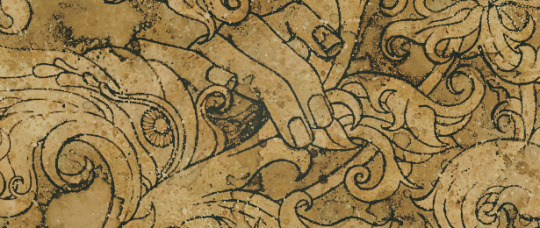
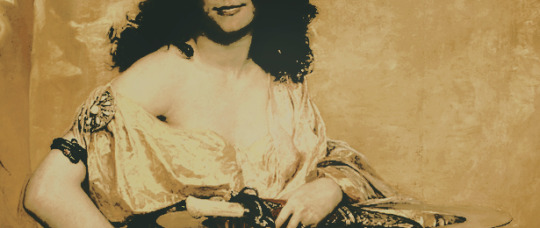

THE SIGNIFICANCE OF YELLOW.
There's a duality to yellow; it's a symbolically-rich oxymoron which, with its conflicting associations, fits Lara completely. Particularly in the 19th Century, yellow was associated with sickness, stigma, and cowardice in Western society, whilst adversely being a colour associated with value, spirituality, and heroism in the East. Interestingly, it would come to be associated with p.ornography in both Western and Eastern society.
In addition to its history, yellow’s ambivalent character as both attractive and repulsive is something that appealed to me in regards to Lara’s character, for it is in-tune with my portrayal of her character; whilst certainly beautiful, with a history of idealism and spirit, this beauty constantly is at-odds with the aspects of her personality that evoke repulsion; her violence, her temper, her blood-lust, and her undeniable greed.
To sum, the following are terms associated with the colour;
indecency. eroticism. literature. salome. spectacle. sarah bernhardt. stigma. reclamation. betrayal. repression. obsession. instability. entrapment. war. memorial. dynasty. wealth. knowledge. censorship. death. ancient. toxicity. poison. arsenic. rarity. art. incompatibility. striking. gold. eternal life. murder.
YELLOW IN LITERATURE.
In 1895, when Oscar Wilde was arrested for 'gross indecency', he was seen to be carrying a French novel with a vivid yellow book which, at the time, would denote literature of an i.llicit and e.rotic nature. People misidentified the material to be The Yellow Book (a British quarterly literary periodical of the time that published the work of authors and artists such as Henry James, H.G Wells, William Butler Yeats, John Singer Sargent, and its first art editor, Aubrey Beardsley) and associated the publication with Wilde. The day after Wilde's arrest, people demonstrated in front of the publisher, and a flurry of media reports soon cemented an association between yellow paperbacks and homosexual content. Somewhat amusingly, Wilde had previously referred to The Yellow Book as 'dull' and 'not yellow at all' in an argument with Beardsley, whom he had once collaborated with for his play Salomé, first published in France. Less amusingly, Beardsley’s reputation was for a time so ruined by tabloid journalism after the arrest of Wilde that he and his sister were forced to vacate the house they shared.
On the subject of Salome, a play that rewrote the biblical figure of the New Testament, yellow plays a particular significance; though the colour is only mentioned seemingly in passing in the play in describing her veils, the Dance of the Seven Veils was infamous in its spectacle and, in contrast with recent depictions of Salome* (notably Rita Hayworth’s portrayal), Wilde reportedly stressed the importance of the dance being in monochrome yellow to the production's costume designer, W. Graham Robertson. Yellow’s importance can also be noted in the portrait of Salomé painted by Henri Regnault, Judith II (Salome) by Gustav Klimt, and Hans Makart’s portrait of the esteemed Sarah Bernhardt**, Wilde’s friend for whom the role Salome was written but by whom it would never be performed.
Makart, a Viennese painter, found his portrait of the ‘Divine Sarah’ was met with much criticism, however, due to its yellow appearance, and thus he withdrew it from an exhibition, an action that upset Bernhardt in a time of rife Antisemitism, thus sensitivity surrounding the figure of Salome. She formulated this response in a letter to Makart that showed her initial appreciation for the portrait, her disappointment in its removal and Makart’s shame for the piece: "Yellow on yellow was the colour of Henri Regault, the late master from Paris, when he painted his Salome shouldn’t the famed Sarah not also be permitted to be yellow? [...] Yes, Mr. Makart, even though my statue has been rescued from the Ring Theatre fire, my portrait must now be driven away. And yet my head and arms are so beautifully made up, the gown, the table cloth, the embroidery, the palm fan, everything is so beautifully yellow. Take assurance that I, too, have become truly yellow from gall, because you, whom I held to be my friend, betrayed me, after you painted me in yellow.” Bernhardt knew of the stigmatising reputation of the colour at such a time, but it would seem she was interested in its reclamation and in showcasing the colour for its beauty; when she acquired the Paris theatre, then the Théâtre des Nations, she had the red plush and gilt replaced with yellow velvet and brocade and renamed it ‘Théâtre Sarah Bernhardt’. The theatre kept the name the Occupation of France by the Germans in World War II, when the name was sadly changed to Théâtre de la Cité because of Bernhardt's Jewish ancestry.
* I do use the figure of Salome as an inspiration in itself, though not from her Antisemitic depiction in the New Testament or as the seductress of Wilde’s play, but rather in how her reputation was created in itself; almost all our information about her derives from the writings of Josephus whom relied heavily on the works of Herod’s court historian Nicolaus of Damascus, and our picture of Salome is marred by the latter’s personal feud with her. Herod’s personal life was full of intrigue and violence, and Nicolaus used Salome as a decoy so as to divert the reader’s wrath at these deeds away from her brother. Thus she is described as being the instigator of all the ‘tragedies' that befell Herod, and it is only after Herod’s death that we learn why Nicolaus hated Salome: in the question of Herod’s will and Herod’s apparent heir, she supported the claim of Herod Antipas, while Nicolaus supported the pretensions of Archelaus, thus in a public hearing on the issue in Rome they were found on two opposing sides of the question. When he eventually wrote on Herodian history, he had still not forgiven Salome for this affront and thus made her into a monster. To me, she seems to be another victim of history being written by male victors.
** Sarah Bernhardt was a primary inspiration for both Lara’s grandmother, Lady Margot Peletier, and Lara herself. Ethnically Jewish, Bernhardt was the child of a wealthy Dutch Jewish courtesan, Judith Bernard. Her father payed for her education, under the proviso that she be baptised as Roman Catholic. However, she never forgot her Jewish heritage. When asked by a reporter if she were a Christian, she replied: "No, I'm a Roman Catholic, and a member of the great Jewish race. I'm waiting until Christians become better."
I have briefly mentioned before the significance of Charlotte Perkins Gilman’s The Yellow Wallpaper in my portrayal, though its relevance is primarily in regards to Lara’s mother, Lady Aemilia E. Croft, and her diagnosis of what was then referred to as ‘puerperal insanity’. Gilman’s story is one of repression and obsession, with the narrator so clearly struggling with her role as a woman of the time and her inability to be the mother that was expected of her, in society that advised women to stick to being mothers and wives and resist the temptation to over-exert themselves physically, creatively, and mentally. The Yellow Wallpaper is famous enough that I don’t think I need to write too much on it, but I would argue that the pairing of yellow and specifically female instability and female entrapment is a clear one, particularly in relation to Lara.
YELLOW IN TRADITION.
The famous song ‘She Wore a Yellow Ribbon’, a song that has existed in various forms for at least four centuries and was a popular U.S Army marching song, also bears plenty of relevance to my portrayal of Lara, based on the tradition of a yellow ribbon being associated with those waiting for the return of a loved one or of military troops who are temporarily unable to come home from war. Thus, yellow too is associated with memorial.
Though in China the term 'yellow', in regards to printed materials like books and images, too has more recently denoted p.ornography and an association for prostitution in Hong Kong the term '黃' being a colloquial for something that is 'p.ornographic' or 'l.ewd' *, it was once a colour favoured by Imperial Emperors. The beginning of the Tang dynasty, Emperor Gaozong expressly forbade others from wearing clothing in of 'reddish-yellow' (his purported reasoning being that it was the colour of THE SUN and, just as there cannot be two suns in the sky, there cannot be two emperors in a nation'), and further regulations on wearing the colour yellow would be set by following dynasties, particularly the Qing Dynasty. Royal palaces were also recognised by their yellow roofs.
* I won't pretend to be an expert on this because I definitely am not, but I do remember reading something about forbidden books of the early Mao era being hidden under yellow covers, so I'll conjecture that perhaps as being why (as well as globalisation) as, due to censorship, it remains a difficult topic to research.
In India, the colour is associated with the Hindu deity Krishna who, generally, is depicted wearing a vivid yellow robe to contrast with his blue skin. Additionally, it’s there often associated with knowledge and peace, arguably both similar or opposing to its usage in Ancient Egypt ... ;
YELLOW IN DEATH.
... there, yellow was worn to signify the dead. In contrast, it has been widely purported that Henry VIII and Anne Boleyn wore yellow on receiving the news of Catherine of Aragon's death in a calculated insult to the memory of the woman Anne Boleyn had supplanted.
I based the colouring of my Google Doc and graphics on Orpiment, an inspiration that might be becoming a little more clear in my most recent promotional graphic, which is attested as another one of the reasons for yellow's negative associations. Orpiment was a pigment relied upon by artists from ancient times until the 19th century, in spite of its extreme toxicity and its incompatibility with other common lead- and copper-based pigments, due to clear and bright yellow pigments being in rare supply.
Orpiment had a hand in the infamous case of the Dutch serial killer Maria Swanenburg, once known locally as 'Goeie Mie' or 'Good Mie' when she cared for both children and the sick and elderly in the poor Leiden neighbourhood in which she lived, who murdered an confirmed number of 27 victims (though she is suspected of possibly having killed more than 90), including her own parents, with Orpiment arsenic between 1880-83.
Though commonly a golden colour, the mineral's streak (the colour of its powder when dragged across an un-weathered surface, which tends to be more consistent than a mineral's apparent colour due to various possible trace impurities) is closer to the pale lemon-yellow. It has notably been found on the walls of the Taj Mahal, as well as in the wall decor of Tutankhamen's tomb and ancient Egyptian scrolls.
Because of its visually striking colour, the mineral itself was of wide interest to alchemists throughout Europe and Asia when searching for a way to make gold and in their quest for eternal life perhaps ironic, considering its poisonous nature. In a similar vein, it was used as a medicine for a time, in spite of its toxicity as an arsenic sulphide mineral. Perhaps more suitably, it too was used to tip poison arrows.
9 notes
·
View notes
Text
Still More Search for the Lost Husband: The Revival of the Prince in Star Wars

Yes, there’s more! Though I covered this to an extent in my original folktale post, I felt a deeper look into the resurrection motif of The Search for the Lost Husband was necessary, especially in light of the new Hux comic. As the lovely @corseque has pointed out (have I tagged her in every post I’ve made so far? I hope so, because I stand on the shoulders of giants….), Ben Solo is clearly presented as the Sleeping Prince, metaphorically dead just like Anakin Skywalker. I’d love to delve a bit into the actual folktales that are the basis of this motif, how it appears as a pattern in Star Wars, and what that means for Ben Solo’s redemption and likely resurrection in The Rise of Skywalker.
In many versions of ATU-425, the lost husband is deathly ill, in a deep sleep, imprisoned, cursed, pretending to be dead, or some combination of the above. As with the flight of the fairy bride, this princely suitor is metaphorically dead, and in rare cases literally dead. After their separation, this is how the searching wife finds him when she comes to his rescue, and she may use any number of means to revive him: Sometimes she makes a blood sacrifice, others she might need to make him a special concoction, and often all that is needed is a declaration of love. Interestingly, the famous kiss of life doesn’t often appear in these tales as it does in the revival of the fairy wife, though sometimes Beauty kisses the Beast when she tearfully agrees to be his wife. Sometimes, the prince does not immediately recognize his wife after his revival, and she must complete another task or put on her royal raiment for him to know her as his true bride.
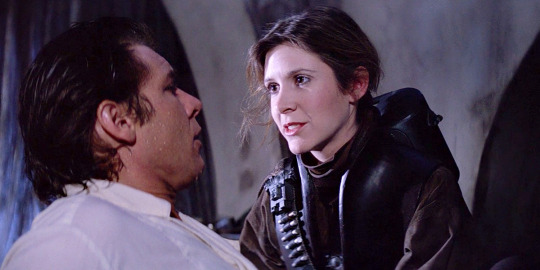
The most obvious place that this tale appears in Star Wars (before the Sequel Trilogy) is in the rescue of Han Solo in Return of the Jedi. Frozen in carbonite “in perfect hibernation,” Han is asleep, enchanted, imprisoned, and nearly dead when the princess creeps into Jabba’s throne room (in a palace of evil on a dead planet, no less) to rescue him. When she frees him from the carbonite, he falls to the floor as if dead, and then wakes to find that he is blind. I intend to cover this in a future post, but blindness in mythology is often used as a metaphor for death (which by the way is a pretty insidious form of historic ableism, but I digress). As Leia’s mask distorts her voice, he does not recognize her at first, but knows her immediately at her declaration of love and subsequent kiss of life. This one scene effectively crams nearly every revival motif from the Search for the Lost Husband into just a couple minutes of screen time.
The other obvious “sleeping prince” in the Skywalker Saga before the sequels is Anakin, although sadly we never see him revived by his bride. This is because his story ends tragically, as the Quest for the Lost Bride tales tend to do. That leaves only one more candidate for the classic rescue and happy ending of the Search for the Lost Husband, and that is our dear Ben Solo. Certainly it’s clear that Ben is in many ways metaphorically dead in the first two films of the final trilogy, but in the recent Hux comic, Lucasfilm has gone out of their way to show him sleeping, mask off, while Hux and another character discuss how much like his princess mother he is.
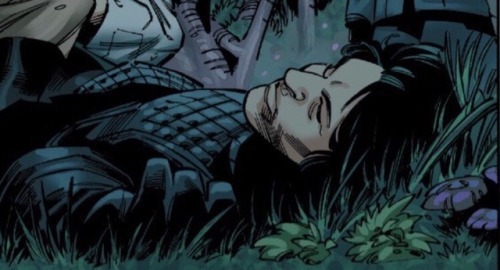
Given that the Lucasfilm Story Group is apparently being about as subtle as a sledgehammer at this point, what might we expect for Prince Ben in The Rise of Skywalker? Well, let’s review several ATU-425 revival stories to see the possibilities:
In East O’ the Sun and West O’ the Moon, the lassie arrives at the castle after her travels to find her prince imprisoned by an evil family of trolls. He is now betrothed to the troll princess, and will marry her in a matter of days. Using gifts given to her by those she met on her journey, the lassie buys the right to spend the night in the prince’s room. However, the cruel trolls make him a sleeping draught, and no matter what the girl tries to wake him, he sleeps on. The lassie tries a second night to wake the prince, but the same thing happens. However, this night, other prisoners hear her weeping and calling to the prince, and tell him when he wakes the next day what they heard. Realizing what has happened, he slyly pours the drink out instead of drinking it, and the third night is awake when the lassie is allowed into his room. They spend the night embracing and planning the defeat of the trolls the next day (achieved by the lassie washing a black shirt to pure white). Check out this stunning illustration by PJ Lynch, inspired by Gustav Klimt’s The Kiss:
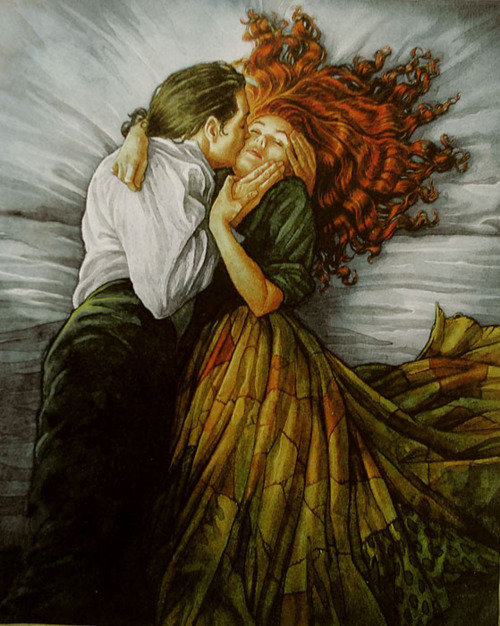
**Trigger Warning for some dark and gruesome imagery in the following paragraphs, especially about blood**
In Pajaro Verde, the prince becomes deathly ill when shards of broken glass become embedded in his body, and flees to his father’s house. In her search for him, the princess comes across little birds who tell her that she must give them a sleeping potion, cut their throats while they sleep, and fill a bottle with their blood. Then, she must cover the prince with the birds’ blood, and the glass will be drawn out of him and cure him. The princess does as they say, and when she arrives at the palace, soaks a sheet in the blood and covers the prince with it. Immediately, he begins to recover, but he does not recognize his wife, and is instead pledged to another. On his wedding day to the false bride, the princess approaches him in all her royal attire and crown, and the prince suddenly remembers her, declaring her his true wife and love. The Enchanted Snake is an almost identical Italian tale, in which a blood sacrifice is again the cure for the ailing prince.
There is also, of course, the classic Beauty and the Beast, in which the neglected Beast lies dying in his garden when Beauty comes upon him after the visit to her family. Realizing her true feelings for him, Beauty calls out to her Beast, kissing him and accepting his offer of marriage. At her confession of love, he transforms into a handsome prince, and he and Beauty live happily ever after.
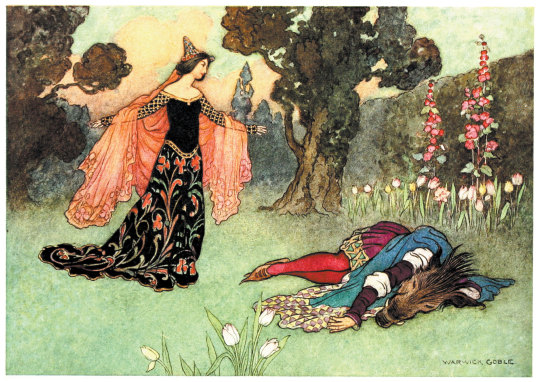
In The Ninth Captain’s Tale, the fair Sittukhan is the first to fall into a deathlike sleep and is revived by a sultan’s son, but is then abandoned by him. Sittukhan enchants herself into a rich and beautiful princess to entice her wayward lover, and failing to recognize her, he begs for her hand. To win her, she tells him, he must wrap himself in burial clothes as if dead and be carried in a funeral procession to a place of rest. This he does, and when they are alone, Sittukhan unwraps her lover’s burial shroud, revealing both him and herself. After teasing him for the lengths he would go to for a bride, she consents to be his wife and they marry. In this story, it is remarkable that the imagery clearly shows her raising her bridegroom from the dead, rather tenderly if somewhat macabre.
From these stories, we may perhaps assume that Ben Solo will indeed die, and that the keys to his resurrection may be a blood sacrifice of some kind and a declaration of love by his true bride. You could even argue that he’s already been baptized with blood in the imagery of cleansing salt in the red wound of Crait. However, few of these stories feature a notable villain comparable to the diabolical Palpatine who will be returning to menace our heroes in The Rise of Skywalker. Given what we know from the trailers, does the Emperor have a clear role in this part of the myth? Does Dark Rey have a part to play?
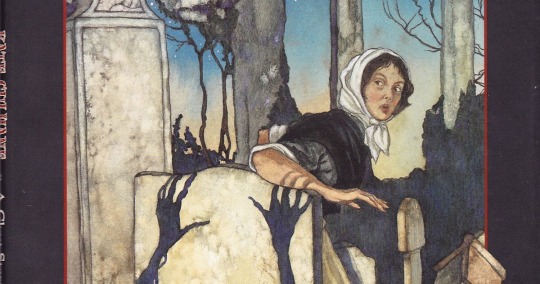
WOULD YOU BELIEVE I actually found in my collection a story that until now, I didn’t realize contained this motif? This is The Blood-Drawing Ghost (the version I have is simply called Kate Culhane: A Ghost Story), an Irish folktale over a hundred years old. In the story, a deceitful young man leaves a fine blackthorn stick on the freshly-dug grave of an old man. Kate, a young woman whom he is courting, offers to retrieve it, but when her hand touches the blackthorn stick, a ghostly voice tells her to open the tomb. Though she tries to resist, Kate is compelled by magic to obey, and she is forced to pull the gruesome corpse from his grave and carry him on her back. Though her burden is heavy and painful, she must carry the dead man a great distance until they reach a house in the village that is unprotected by holy water. Inside, the corpse searches for something to eat, but Kate can find only oatmeal. Upstairs, they find that the wealthy family has three sons, and the dead man forces poor Kate to hold a bowl under their hands as he drains the blood from each one in turn. He then has her mix the blood with the oatmeal and eats it, instructing her to eat it as well, but she cleverly hides the food in a handkerchief instead.
The old man then forces Kate to again take him upon her back and carry him back to his grave. On the way, she asks if there is any cure for the dead young men whose blood was drained. The old corpse tells her that if only a bit of the oatmeal mixture had been saved, just a bite in each man’s mouth would bring him back to life, and they would never know of their deaths. At the graveyard, the dead man tells Kate that as she has eaten his food, he will pull her into the grave with him before the cock crows three times. In my version, he does actually try to drag her into the grave, but thankfully dawn breaks and the brave girl is able to escape. She makes her way to the house of the three dead sons, where the family has discovered them and is lamenting their misfortune. She tells the family that she can revive the young men if only they will give her the eldest as her husband. They agree, and she feeds the sons the bloody oatmeal she had saved in the handkerchief, reviving them immediately. Kate marries the eldest son and they live happily for all their days.

Call me crazy, but this looks like a great plot outline for The Rise of Skywalker based on what we know so far. First, there is the brave girl who goes to retrieve a special stick, or in this case the legacy lightsaber, as Rey did in The Force Awakens. When she touches it, she is drawn into a dark struggle between good and evil, life and death. If Rey becomes a target for the risen spirit of the Emperor (who resembles nothing so much as a corpse) as many suspect, then he may attempt to use her to do his dark bidding, or convince her to become his apprentice/alcolyte. At least, this is what is suggested by the appearance of Dark Rey and some of the links she has to Palpatine in her musical theme and backstory on Jakku. Further, the Emperor has already tried to drain two sons of the Skywalker line (Anakin and Luke), and now it seems he may attempt to drain a third (Ben). There’s certainly been a lot of talk about Ben Solo’s bloodline, at least.
Just as Psyche was instructed not to eat the food of the Underworld lest she be forced to remain there forever, Kate has the sense not to share in the bloody feast of her deathly captor. Since we know Rey will likely have a “dark night of the soul” in Episode IX in which she is sorely tempted by the Dark Side, I take this as the model for her resisting that temptation to taste the fruits of death. And finally, just as the corpse attempted to drag Kate into his grave with him, Darth Sidious will make one last effort to entrap or destroy our heroine, but she will escape him. Unfortunately, it is still too late for Ben, the third son whose life he drained away. Or is it? Perhaps Rey, in her brush with the Dark Side, will have learned the cure to rouse her beloved from his deathly slumber. Perhaps it will be the sacrifice of Ben’s own blood that saves him, along with the love of a clever girl.
Hope you all enjoyed this latest installment! Let me know if there are any specific folklore topics you’d like me to explore in Star Wars. This has been a great way to pass the time during the agonizing wait for TROS!
#the search for the lost husband#search for the lost husband#atu 425#star wars meta#tros speculation#tros theories#tros predictions#The Rise Of Skywalker#reylo#reylo meta#HanLeia#sleeping prince#resurrection#the resurrection tag#star wars mythology#folklore#aarne thompson uther#mythology#fairy tales#east of the sun and west of the moon#beauty and the beast#kate culhane#Return Of The Jedi#save ben solo#bendemption#ben solo#palpatine#emperor palpatine#darth sidious#rey of jakku
145 notes
·
View notes
Text




1. “Water Serpents” by Gustav Klimt
2. “Ophelia” by Sir John Everet Millais
3. “Ophelia” by Robert Walker
4. “Without hope” by Frida Kahlo
I find all these works extremely interesting and they all have relevant and similar underlying messages conveyed in very different perosnal ways. Gustav Klimts work is very senual and akmost erotic. Howver i really like his use of gold and his way of somehow interwining the bodies along with flowers and nature and somehow makes it all feel whole, as if they are all flowing. The way the two far right faces are positioned it almost looks as if they are flying, as if they where the wind, or indeed water serpents breaking through the water. I love the way the hair is such a vital component of this piece. The way is flows and is swollowing the flowers and dragging them with them. The colours and details are quite effective for this feeling of motion
The two ophelias by Sir John everett millais and Rovert walker are based on the same character. Millais work depicts a very quiet moment, a tragic still of the character, partially submerged, the colours are quite muted and yet very effective, her red hair a key element of this painting.
Robert walkers approach is far more frantic, vibrant and bold. There is almost distress, a fighting back. His colours are far more vibrant and almost luminous. His character his however trapped beneath a fishing net completley submerged. Thee is a sense of water creature to this painting too. It is quite relevant as many animals loose their lives to our lack of care and the pollution. Old nets are in fact a big issue for sea life. This is almost ironic as it is a human trapped in one.
Frida Kahlo suffered a terrible accident which led to many years of pain and siuffering both physically and mentally. It translates through her art quite boldly and candidly. I chose this image because it is a protrait of herself stuck in her bed. It has an almost surrealist attitude to it yet is conveys something so personal, a frustration, a melancholy. The funnel which reaches her lips is full of dead and maimbed animalsd, skulls and symbols of death and suffering. Mutilation and torture. It is perhaps what she is spewing out or perhaps it is all she feel is what feeds her. Either way she is trapped. Submerged in her bed, suffocated by a sinister misery.
1 note
·
View note
Text

these days, i am really fucking trying. I’ve been quarantining for almost two whole months— I’ve only left the house for the pharmacy and a necessary medical test. I’ve been reading a shit ton — standouts have been Under the Net by Iris Murdoch, The Moon and Sixpence by Somerset Maugham, and The Enchanted April by Elizabeth Von Arnim, and I’m currently reading Howards End by E.M. Forster which i already know will be a new favorite. I’ve been watching a different “Old Hollywood” film with my Grandma every night and falling down rabbit holes of obsessions with actors that aren’t even alive anymore and movies that people watched to take their minds off of problems during the Great Depression or WWII or whatever. I am truly always questioning why I live in this century when I would have done so much better in the early 20th, and why in the world am I so obsessed with figuring out how British culture of the early 1900s operated when I don’t even have words to describe what’s happening in America a hundred years later?
I guess that’s what this boils down to— since the world turned on it’s axis in March, I have felt like things are too serious in the world, too life-or-death and so unnatural and surreal that I have no way to put it into a context, and I have no idea what to possibly say. And of course there IS a context, for instance the Spanish Flu that happened during the very time period I’m fascinated by, but I’m just so SCARED of this disaster because that is so different from ANYTHING I’ve ever experienced.
My first concern is my grandma, her health and well-being — before I do ANYTHING now I have to weigh the pros and cons of me exposing myself to the world and then exposing her. I do not want to go out and work at my former part time job again, etc, until it’s almost totally safe to do so, and god only knows when that will be. My second concern is myself — every day I get increasingly more frustrated with the reality that the life I had dreamed of for the ENTIRE time I was abroad and in grad school, a life where I could have my own flat and a little cat and a job I at least moderately like, the life I had thought was so incredibly little to wish for, was stopped in its tracks before it could even begin. I have $8 in my bank account and I feel so horrible that I’m not independent at all anymore. Truly, at a base level, I just want to HELP people and feel connection and finally have everything I went through in undergrad and grad school pay off in the form of me finally getting to be independent and have a fucking development job. But no. No. And it makes me want to scream.
The entire state of the world itself is of course even more alarming but I truly can’t even think about that. I have to focus on keeping my grandma safe, which is kind of maybe a lot to ask of me. I’m going to be 24 next month, which is incredibly alarming. I’m trying to escape to a life that existed 70-100 years ago in order to maybe forget about everything else. I can’t sleep at night then I sleep until 11am or noon, sometimes I feel so panicked and unsettled and can’t discern why, I feel sluggish and lazy and inconsequential. I feel like everything I’ve been working towards for the last decade doesn’t mean anything. Sure, I know the arts matter, but like.... do the /arts/ actually /matter/?
And maybe this is all silly but I’m so scared of what the world is going to be like even after we have a vaccine — things will never be the same again, really. But for right now, here’s me in a Klimt t-shirt given to me by my lovely teenage cousin and trying to smile because I did some gardening and cleaned the deck furniture today and sat in the sun and read the clever writings of Forster. And it’s the small things that truly matter most, right now, and I don’t have an ending to this but to just say that I’m scared. I hope you and your families are all well and that you take joy in some small pleasures, too 💓🌿🌸🌻
2 notes
·
View notes